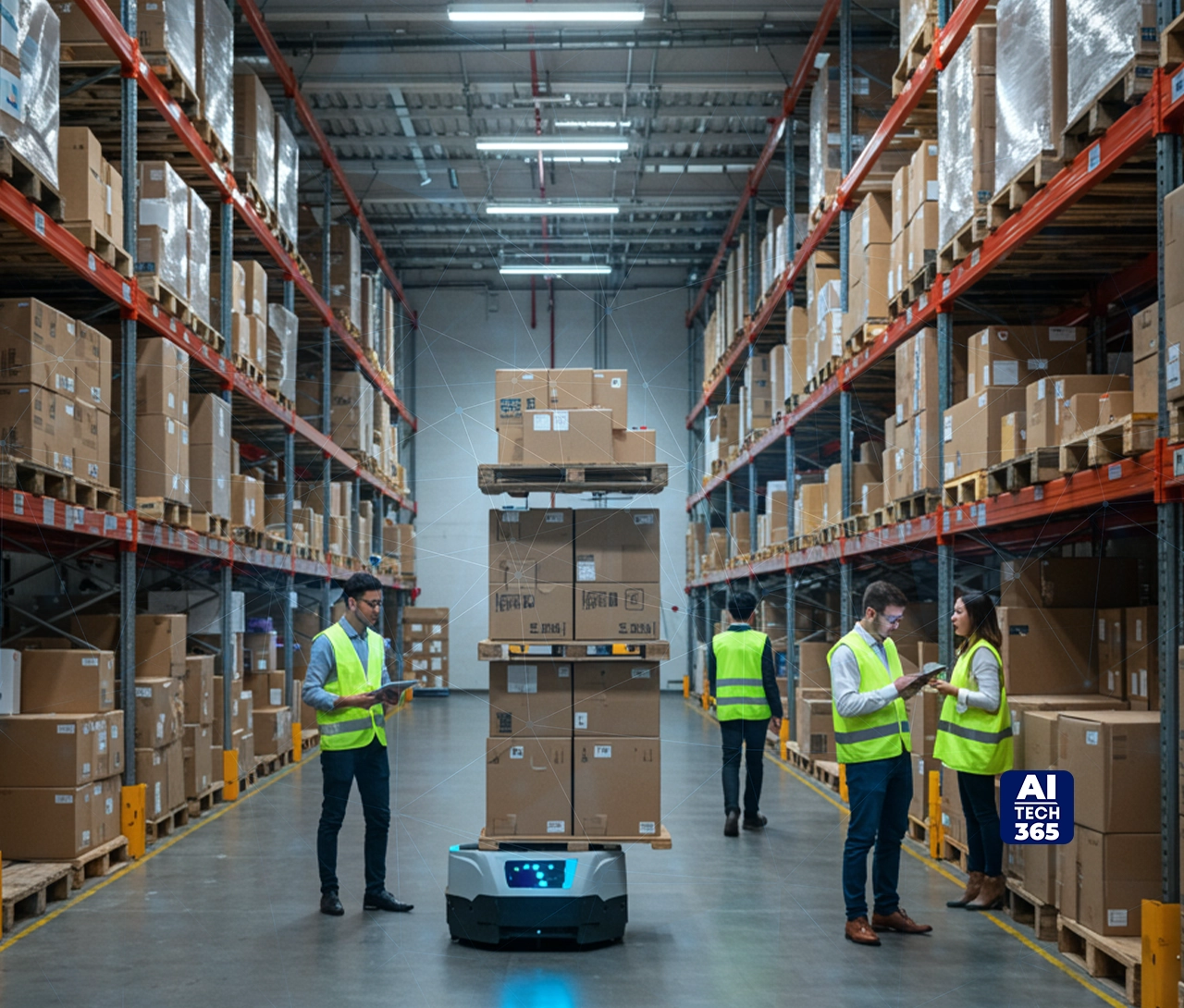Amazon sits in a league of its own. It’s not just the world’s largest digital retailer but also a logistics empire and an advertising powerhouse rolled into one. Managing this scale is a near-impossible challenge without intelligence that can think ahead. AI is what makes that possible. It manages billions of daily transactions, predicts global demand shifts, and optimizes trillions of miles of movement across its network. In Q3 2025 alone, Amazon reported net sales of US$180.2 billion, up 13% year-on-year, showing the sheer magnitude of operations now fueled by AI precision.
At the center of this machine lie three powerful engines that redefine modern commerce: AI-Driven Logistics that sharpen efficiency, Hyper-Personalized Recommendations that elevate customer experience, and Marketing Optimization that drives long-term value.
This article breaks down how Amazon’s foundational AI models power each of these pillars and extracts a practical framework for B2B and retail leaders focused on operational excellence and sustained customer lifetime value.
AI-Driven Logistics and the Fulfillment Network
Amazon isn’t just moving boxes; it’s predicting the movement of the world. The company’s fulfillment network runs on a brain built from generative AI and deep learning models that don’t just study past orders, they anticipate what a customer in a specific zip code might buy next week and when. The accuracy of this prediction is the main reason why the product frequently seems to have been standing by for you even before you pressed the button ‘Buy.’ By placing products nearer to the areas of highest demand, Amazon not only minimizes transportation over long distances but also lowers the delivery time and saves millions of miles in shipping. This is the result of algorithms taking over the control of location while humans are still following the spreadsheets.
Behind that seamless delivery experience sits Amazon Web Services, the AI powerhouse funding this logistical mastery. In Q3 2025, AWS reported revenue of US $33 billion, a 20 percent jump year on year. That growth is not just cloud money; it is the infrastructure that keeps Amazon’s AI commerce engine running across forecasting, routing, and robotics.
Inside the warehouses, the future looks metallic and self-aware. Amazon has now deployed one million robots across its operations, each guided by AI and computer vision to locate, lift, and route inventory faster than any human crew could. The system is not static either. A new generative AI foundation model has already made those robots about 10 percent more efficient in their travel paths, squeezing time out of every retrieval and placement cycle. When millions of micro movements are optimized like that, the ripple effect touches everything from warehouse throughput to customer satisfaction.
On the roads, algorithms continue the relay. AI systems like Wellspring analyze live traffic, weather, and even building layouts to reroute deliveries in real time. What looks to customers like an ordinary ‘out for delivery’ update is in fact a thousand variable equation playing out on the fly.
The lesson for B2B and retail leaders is blunt but valuable. You cannot de risk your supply chain by staring at old data. Predictive maintenance, regional inventory placement, and real time optimization must replace static planning. The world’s biggest retailer did not scale on instinct; it scaled on intelligent foresight. If AI can plan your customer’s next delivery, it can just as easily plan your next move.
Hyper-Personalized Recommendations and CX
Amazon’s recommendation engine isn’t a product suggestion tool anymore. It’s an experience engine that learns, predicts, and nudges with precision most brands only dream of. Behind every ‘you might like this’ lies an ecosystem that analyzes billions of sessions, clicks, scrolls, and even subtle mouse movements. It’s not guessing what customers want, it’s interpreting intent in motion. This is where Amazon’s AI turns personalization into prediction. The system now focuses on next best action insights, anticipating what each user should see, hear, or buy next across the homepage, email, or app. The result is a fluid experience that feels less like browsing and more like being guided by someone who knows your mood before you do.
Then comes Rufus, Amazon’s generative AI shopping assistant, turning search into conversation. Instead of typing a rigid keyword string, users can now ask, ‘What’s a good laptop for video editing under $1,000?’ and get an answer shaped by large language models that understand nuance, context, and preference. Combining visual search with this makes discovery an intuitive action. A photo can be taken, the desired item can be described, and the Amazon AI will take care of everything else. These LLMs are also summarizing reviews, deciphering feature comparisons, and converting technical jargon into everyday language behind the scene. To sum up, Amazon has redesigned the shopping path with comprehension, not mere accessibility, as the core principle.
For brands, that’s a wake-up call. The technology may look magical, but the lesson isn’t. Personalization doesn’t start with fancy AI models; it starts with data unity. Connect your customer service interactions, website history, and transaction data into one consistent view. Every disconnected dataset is a blind spot where personalization fails. The smarter move is building internal data models instead of leaning on generic SaaS tools that only skim the surface.
What Amazon proves is simple. Customer experience isn’t about showing more options, it’s about showing the right one, at the right time, with zero friction. That’s not marketing anymore, it’s micro understanding at scale. And if your business isn’t chasing that level of clarity, someone else’s AI will soon understand your customer better than you do.
Also Read: How Microsoft Uses AI to Drive Enterprise Productivity
Marketing and Customer Lifetime Value (CLV) Optimization
Amazon’s marketing engine runs on something far more potent than creativity, it runs on computation. The ad tech platform powered by artificial intelligence of the company is responsible for the management of trillions of impressions, and at the same time, it learns what ad to show to which user at what moment. It is not only a question of visibility but also a question of accuracy. The real-time bidding systems evaluate the probability of conversions in milliseconds and make a decision as to which placement (Sponsored Product, Display, or Video) will yield the highest return. This is like marketing on auto mode, but the IQ that is constantly evolving every second drives the process.
At the heart of this evolution is predictive intelligence. The same forecasting models that power Amazon’s logistics also fuel its marketing decisions. When Amazon plans promotions like Prime Day, it’s not guessing what people might buy. It’s running deep simulations that forecast demand, inventory flow, and ad performance together. That alignment between marketing and supply chain is what keeps deals consistent, margins healthy, and customer experience seamless.
The creative side isn’t left behind either. Amazon’s AI runs endless experiments on ad headlines, product images, and calls to action, optimizing for each audience segment’s response pattern. It doesn’t rely on assumptions about what works, it measures, adapts, and iterates until it gets it right. This is also where customer lifetime value (CLV) prediction steps in. Amazon’s models can identify potential high-value customers early, letting brands focus retention and loyalty campaigns where they’ll actually matter. The math is simple, the sooner you know who your best customers are, the more efficiently you can spend to keep them.
Amazon summed up its vision at unBoxed 2025, calling it ‘innovation unleashed’ and showcasing new tools reshaping full-funnel digital advertising. But what it really demonstrated was a shift in mindset. Marketing is no longer about manual tweaking of keywords or reacting to campaign metrics after the fact. It’s about goal-based automation, setting the objective and letting AI optimize toward it.
For leaders, the message is clear. If you’re still managing your ad spend manually to the smallest detail, that means you’ve already fallen behind. The future is for those teams that permit AI to lead the way, set unambiguous performance goals, and prioritize strategy over spreadsheets. For, in the age of smart marketing, what gives you the greatest advantage over the competition is not your communication but the speed at which your system learns.
Actionable Roadmap for B2B and Retail Integration
Every business wants Amazon-scale AI, but few realize that the foundation isn’t the model, it’s the data. Phase one starts with data centralization. You can’t build predictive systems if your ERP, CRM, and marketing tools live in silos. The real goal is a unified source of truth that connects supply chain data, customer behavior, and financial performance. Without it, every AI initiative becomes guesswork dressed as strategy.
Second stage is to focus on micro-wins rather than on moonshots. Usually, the leaders are the ones to be defeated because they prefer huge changes to solving just one important issue at a time. Take a small step, show the impact, and then expand it. For B2B firms, a very basic thing like product categorization automation could reduce the labor-intensive work by hundreds of hours. For retail, personal email segmentation might lead to increased engagement without necessitating a complete technology overhaul. Each success builds internal confidence and cultural momentum.
Finally, the cultural shift is the hardest but most powerful phase. Amazon’s biggest edge isn’t its algorithms, it’s its mindset. Every decision is tested, measured, and refined by data. Leaders need to foster that same habit, where intuition meets evidence and every hypothesis is open to challenge. The organizations that win in AI commerce won’t just adopt new tools, they’ll adopt new thinking.
The Future of Autonomous Commerce
Amazon’s AI engine runs on three powerful pillars that define the future of commerce. Efficiency comes from predictive logistics and intelligent fulfillment. Experience is driven by hyper-personalized recommendations and conversational discovery. Value is created through marketing systems that learn, adapt, and optimize every interaction. Together, they form a closed loop of insight and action that few companies can match.
The AI Commerce Engine is no longer an experiment, it’s the standard. B2B and retail leaders who hesitate risk falling behind those already fortified by data-driven ecosystems. The window to move from pilots to full-scale integration is closing fast.


